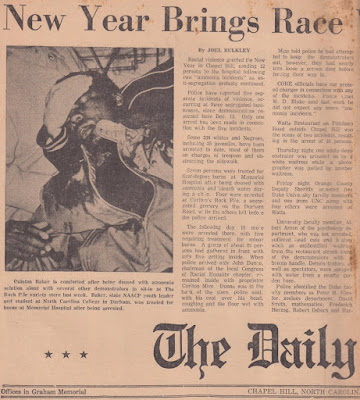That’s not to say that hostility or even impoliteness was the mark of the day. I vividly recall an incident when a black lady got stuck on ice beside the road in front of my house (the main road from Salisbury to Granite Quarry). I labored until my hands were nearly frozen and I was exhausted from helping to push her car back on the road. No thought of race in that incident. Just helping someone whose car was stuck.
Once when I was in the 4th grade, a boy at school named Ronnie Hopkins used the N-word in a scurrilous manner, and I quickly let him know that I would rather be Ollie Matson than Ronnie Hopkins. I doubt he knew who Ollie Matson was, but he could conclude that I didn’t like his comment.
I don't recall any prejudicial comments about race within my home. I certainly heard racial slurs from classmates. At home race was basically not talked about. But I did inherit from my parents a sense of sympathy for the underdog. Everyone in my house was an avid Dodgers fan during the era of Jackie Robinson, Don Newcomb, and Roy Campanella. And we all hated the lily white New York Yankees. When we were in New Orleans in 1954 on a family vacation, my dad took a seat in the rear section of a city bus when all the "white" seats in the front were filled. "No need to let a good seat go to waste," he observed. Not a political act in any sense of the word. Just a practical move.
Chapel Hill (1961-1965)
In the fall of 1963 Chapel Hill NC became one of the prime national targets for integrating public accommodations. The main focus was on dining facilities, with a secondary focus on motels. But segregation was the practice of the day for all sorts of businesses. And resistance to integration was strong.
 |
| Advertisement for Colonial Drug Co. on Franklin St. in Chapel Hill
Click image to enlarge for reading
|
- I Raised my Hand to Volunteer
- Student Protest Movements at the University of North Carolina at Chapel Hill: Civil Rights Protests (1963-1964)
- Integration Sit-Ins
 |
| Sit-in at post office (federal property so city police can't arrest) Left: Pat Cusick, 3rd from left: John Dunne |
I was led into the civil rights movement by my Episcopalian roommate from Atlanta. Most of the demonstrators were black folks from the local community. Participation by UNC students was not widespread. While there was considerable sympathy among UNC faculty and students, only a few campus leaders emerged. Among them were John Dunne and Pat Cusick. I have strong memories of Quentin Baker (photo in news clipping below). Quentin also had the distinction of being urinated on by the female owner of a motel on the road between Chapel Hill and Pittsboro. Quentin went limp, and the owner raised her skirt, squatted over him, and let go.
There was a girl named Karen Parker who was very visible in the movement. Karen turned out to be the first black female to earn an undergraduate degree from UNC Chapel Hill. She was very smart, and I think I had a crush on her. Karen had a long career in NC journalism, most of it with the Winston-Salem Journal, and she's now in the NC Journalism Hall of Fame.
Hostilities did flare occasionally from proprietors of establishments where sit-ins were taking place. One such incident occurred at a local segregated variety store. The Daily Tarheel (student newspaper at UNC Chapel Hill) gave the following account …
 |
Click photo to enlarge for reading
|
 |
Click photo to enlarge for reading
|
- segregated schools
- segregated restaurants, bars, and other dining facilities
- segregated motels and other public accommodations
- segregated swimming pools, public transit, movie theaters, etc.
 |
| A 1963 listing of demonstration targets in Chapel Hill by Student Peace Union
Click image to enlarge for reading
|
In those birthing days of the civil rights movement, the emphasis was on breaking down barriers. Issues like school busing to promote integration and affirmative action were still on the distant horizon. Until you get your foot in the door, there's no point in arguing about what constitutes complete success.
